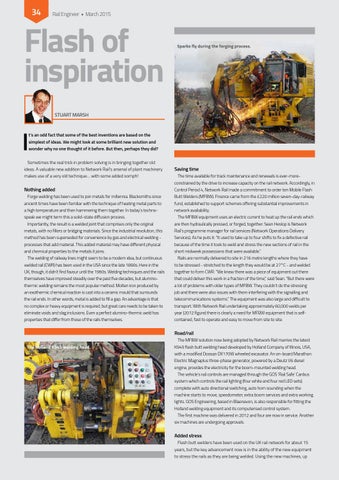34
Rail Engineer • March 2015
Flash of inspiration
Sparks fly during the forging process.
STUART MARSH
I
t’s an odd fact that some of the best inventions are based on the simplest of ideas. We might look at some brilliant new solution and wonder why no one thought of it before. But then, perhaps they did?
Sometimes the real trick in problem solving is in bringing together old ideas. A valuable new addition to Network Rail’s arsenal of plant machinery makes use of a very old technique… with some added oomph!
Nothing added Forge welding has been used to join metals for millennia. Blacksmiths since ancient times have been familiar with the technique of heating metal parts to a high temperature and then hammering them together. In today’s technospeak we might term this a solid-state diffusion process. Importantly, the result is a welded joint that comprises only the original metals, with no fillers or bridging materials. Since the industrial revolution, this method has been superseded for convenience by gas and electrical welding processes that add material. This added material may have different physical and chemical properties to the metals it joins. The welding of railway lines might seem to be a modern idea, but continuous welded rail (CWR) has been used in the USA since the late 1890s. Here in the UK, though, it didn’t find favour until the 1960s. Welding techniques and the rails themselves have improved steadily over the past five decades, but aluminothermic welding remains the most popular method. Molten iron produced by an exothermic chemical reaction is cast into a ceramic mould that surrounds the rail ends. In other words, metal is added to fill a gap. An advantage is that no complex or heavy equipment is required, but great care needs to be taken to eliminate voids and slag inclusions. Even a perfect alumino-thermic weld has properties that differ from those of the rails themselves.
Saving time The time available for track maintenance and renewals is ever-moreconstrained by the drive to increase capacity on the rail network. Accordingly, in Control Period 4, Network Rail made a commitment to order ten Mobile Flash Butt Welders (MFBW). Finance came from the £220 million seven-day-railway fund, established to support schemes offering substantial improvements in network availability. The MFBW equipment uses an electric current to heat up the rail ends which are then hydraulically pressed, or forged, together. Sean Heslop is Network Rail’s programme manager for rail services (Network Operations Delivery Services). As he puts it: “It used to take up to four shifts to fix a defective rail because of the time it took to weld and stress the new sections of rail in the short midweek possessions that were available.” Rails are normally delivered to site in 216 metre lengths where they have to be stressed - stretched to the length they would be at 27°C - and welded together to form CWR. “We knew there was a piece of equipment out there that could deliver this work in a fraction of the time,” said Sean. “But there were a lot of problems with older types of MFBW. They couldn’t do the stressing job and there were also issues with them interfering with the signalling and telecommunications systems.” The equipment was also large and difficult to transport. With Network Rail undertaking approximately 60,000 welds per year (2012 figure) there is clearly a need for MFBW equipment that is selfcontained, fast to operate and easy to move from site to site.
Road/rail The Holland K945 welding head.
The MFBW solution now being adopted by Network Rail marries the latest K945 flash butt welding head developed by Holland Company of Illinois, USA, with a modified Doosan DX170W wheeled excavator. An on-board Marathon Electric Magnaplus three-phase generator, powered by a Deutz V6 diesel engine, provides the electricity for the boom-mounted welding head. The vehicle’s rail controls are managed through the GOS ‘Rail Safe’ Canbus system which controls the rail lighting (four white and four red LED sets) complete with auto directional switching, auto horn sounding when the machine starts to move, speedometer, extra boom services and extra working lights. GOS Engineering, based in Blaenavon, is also responsible for fitting the Holland welding equipment and its computerised control system. The first machine was delivered in 2012 and four are now in service. Another six machines are undergoing approvals.
Added stress Flash butt welders have been used on the UK rail network for about 15 years, but the key advancement now is in the ability of the new equipment to stress the rails as they are being welded. Using the new machines, up
